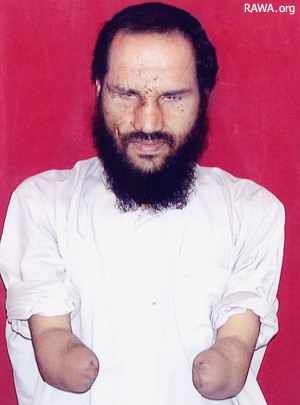Toronto Star, May 22, 2008
Afghanistan a land of disabled and discarded
The survey put the tally of severely disabled Afghans at up to 867,000.
Rosie DiManno
Their broken bodies break the heart.
A legless man trundled down the middle of the street in a wheelbarrow. A little boy with deformed and useless limbs scuttling across a bridge like a crab, wrapping his thin arms around a passerby's ankle, unwilling to let go, begging for change. A keening woman with empty eye sockets, her palms upturned, squatting at the edge of traffic.

According to UN Afghanistan is one of the top three most-mined countries on the planet. About 200,000 civilians have died and 400,000 have been disabled in mine incidents in Afghanistan. There are 100,000 children disabled in Afghanistan.
Afghanistan is a country of the lame and the maimed.
It is doubtful whether any place on Earth has a larger proportion of disabled and often discarded citizens, eking out an existence on the margins of charity.
Three decades of war, millions of mines and unexploded ordinance (UXO) for children to trip over, suicide bombers, birth defects due to clannish intermarriage, congenital disabilities never corrected for lack of health care, ordinary ailments left untreated and the vast afflicted detritus accrued from preventable diseases such as polio, to say nothing of inestimable psychological trauma: Afghanistan is a wasteland of the mutilated and crippled.
"Yes, go ahead and take my picture," agrees Ahmad Hamid, one-legged and blind, pleading for alms on a blanket spread near the bazaar, surrounded by several of his young children. "Show them to the president. Show him how his people, his brave mujahideen, have to beg in the streets for food."
Nearly all amputees – arm missing here, leg missing there – claim to have been mujahideen, Afghanistan's patriots, although often their age belies this. Doesn't mean, though, that they aren't victims of war and its radiating miseries, or even a current insurgency that claims more victims among the citizenry than those in uniform.
"It was a fragment of a bomb," explains Zalmai, 23, lifting the stump of an arm. "It happened near Bagram five years ago, a Taliban explosion. Doctors could do nothing but cut off what was left."
Hayatolla, 30, says he was a teenage labourer in the north when he stepped on a land mine and lost his leg. "It totally changed my life. I can't work any more. I came to Kabul because I didn't want to be a burden on my family. But 15 years I've been begging on these streets. I live by the kindness of people who feel sorry for me."
Disabled Afghans receive 400 Afghanis a month in benefits from the government – about $8 Canadian. But they have to go to an office to get the money and a great many are totally immobile, isolated.
A 2005 disability survey conducted by Handicap International found that upwards of 2.7 per cent of the population – or one out of every five households – suffers from a "severe'' disability and a further 4.8 per cent from a "minor" disability. The survey put the tally of severely disabled Afghans at up to 867,000.
War-related disabilities, primarily loss of limbs, account for an overwhelming proportion of non-birth-defect cases. Land mines, bullets, grenades and booby traps are among the causes. Out of a population of 25 million, 123,000 Afghans have been directly incapacitated by war and its consequences.

Landmine victim: Afghanistan has upto 867,000 people with disabilities.
Many can't dress themselves, can't wash themselves, can't go to the toilet unaided, can't do simple household chores, can't work and can't budge without assistance.
There are so many urgent problems facing Afghanistan. Addressing the needs of the disabled has not been a priority for the government.
The Swedish Committee for Afghanistan now has responsibility for a joint UN-NGO project started in 1995 to help integrated the handicapped into the community. Rehabilitation of Afghans with Disabilities functions in 13 provinces with 500 staff and 600 volunteers.
"We go where nobody else will go," RAD program co-ordinator Zemarai Saqeb told the Star.
"In Afghanistan, all people have economic problems compared to five years ago. But for the most vulnerable people, it has been getting worse. There are simply insufficient services and funds for people with disabilities."
The RAD program has five components: community mobilization, awareness and advocacy; employment support; special/inclusive education; physiotherapy; and orthopedic workshops.
It's tough to identify the needs of a non-visible disabled community, especially in rural areas, Saqeb said.
Disabled people have received training in such trades as carpentry, tailoring and computer technology; many become breadwinners for themselves and their families.
RAD has directly helped 170,000 Afghans, including diagnosis of physical problems, getting medical help and ensuring rehabilitation and physiotherapy.
More orthopedic technicians are being trained. The disabled themselves staff four workshops that manufacture prosthetic devices – 7,000 a year distributed at no cost – and crutches.
"A lot of those beggars on the street have artificial limbs," Saqeb points out, "but they don't use them when they're asking for money."
It's not a con. It's just that standing on your own two feet in Afghanistan is sometimes better done by teetering on one.
Characters Count: 6924
